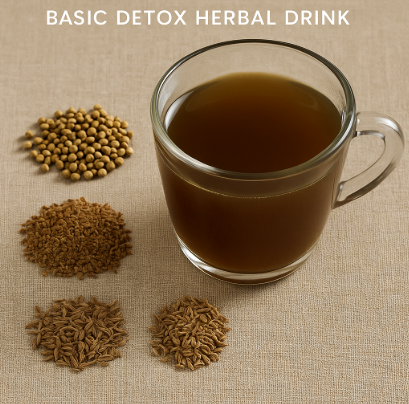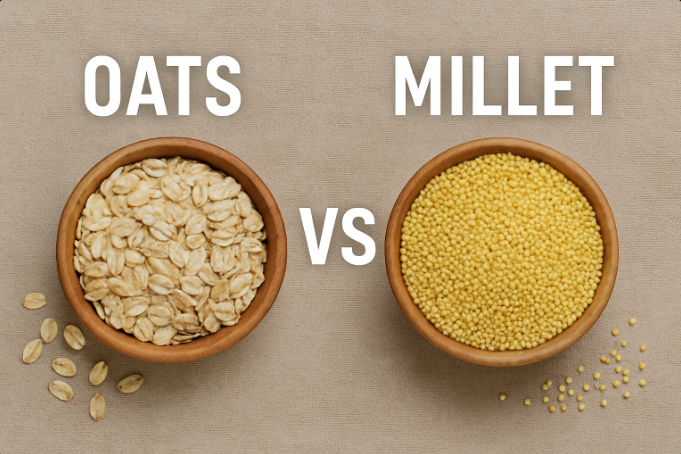Oats vs Millets – In the ever-growing world of health foods, grains are taking center stage. Among the many options, oats and millets have become two popular choices for health-conscious eaters. Both are whole grains, rich in nutrients, and incredibly versatile—but how do they stack up against each other? Let’s explore the benefits, differences, and ideal uses for oats and millet to help you make the best choice for your diet.
Table of Contents
Oats vs Millets: History
A Brief History of Oats
Oats (Avena sativa) are believed to have been first cultivated around 1000 BC in Europe, particularly in what is now Germany and Switzerland. Though wild oats grew in the Fertile Crescent, they were initially considered a weed among wheat and barley crops.
Oats gained popularity in Scotland and Ireland, where the cool, moist climate was ideal for their growth. Scottish porridge and oatcakes became cultural staples, and oats were praised for their hardiness and nourishing qualities.
A Brief History of Millets
Millets are far older, dating back over 7,000 years. They were one of the first grains cultivated in both Africa and Asia, particularly in India and China. In fact, millet predates rice in ancient Chinese agriculture.
Millets played a vital role in ancient Indian diets and were extensively used in traditional medicine systems like Ayurveda. Because of their drought-resistant nature, millets became essential in arid regions, providing a reliable food source for centuries.
Oats vs Millets: Nutritional Comparison (Per 100g Raw)
Both oats and millets are nutritional powerhouses that deserve a place in your kitchen.Here’s a detailed health comparison between Oats and Positive Millets based on data from the U.S. Department of Agriculture (USDA) and the Indian Institute of Millets Research (IIMR). This comparison focuses on key nutritional aspects per 100 grams of the raw grains.
| Nutrient | Oats | Positive Millets (Average) |
|---|---|---|
| Calories | 389 kcal | 346–378 kcal |
| Protein | 10.9-16.9 g | 8.3–12.5 g |
| Total Fat | 6.9 g | 2.9–4.2 g |
| Carbohydrates | 66.27 g | 72–73 g |
| Dietary Fiber | 10.6 g | 7.6–12.5 g |
| Iron | 4.72 mg | 0.5–15.2 mg |
| Calcium | 54 mg | 11–344 mg |
| Potassium | 429 mg | 220 mg |
| Gluten Content | Gluten-free | Gluten-free |
| Glycemic Index (GI) | Medium (55–60) | Low (35–50) |
🔍 Key Insights:
- Protein: Oats have a higher protein content, making them beneficial for muscle repair and growth.
- Dietary Fiber: Both grains are rich in dietary fiber, but certain millets like Barnyard and Brown Top have higher fiber content, aiding in digestion and satiety.Wikipedia
- Minerals: Millets, especially Finger Millet (Ragi), are exceptionally high in calcium, supporting bone health.Just Agriculture
- Glycemic Index: Millets generally have a lower GI, making them more suitable for blood sugar management.
- Sustainability: Millets are drought-resistant and require fewer resources to cultivate, promoting sustainable agriculture.
✅ Summary:
They offer complementary health benefits and can add diversity to your meals. While oats are a nutritious grain, especially noted for their protein and fiber content, positive millets offer a broader range of minerals and a lower glycemic index. Incorporating a variety of millets into your diet can provide diverse health benefits and support sustainable food practices.
Oats vs Millets for Indians – As Explained by Dr. Khader Vali, the Millet Man of India
If you missed our blog post on why Dr.Khader Vali is known as the Millet Man of India & how he is healing the nation,click here.
When it comes to healthy grains, oats and millets are often compared. Both are rich in nutrients, but if you ask Dr. Khader Vali, the renowned Millet Man of India, there’s no contest — millets are the superior choice.
Dr. Vali, a food scientist and holistic health advocate, has spent decades researching the healing power of ancient Indian grains. His conclusion? Millets are not just food; they are medicine.
He strongly advocates for millets over other grains like oats, quinoa, rice, or wheat. His support for millets is deeply rooted in both traditional wisdom and scientific reasoning.
Here’s why Dr. Khader Vali suggests millets and not oats:
🌿 Why Dr. Khader Vali Prefers Millets Over Oats
- ✅ Indigenous and Naturally Grown in India
Millets are native to Indian soil and require no chemicals or fertilizers, unlike imported oats. - ✅ Gluten-Free and Gut-Friendly
All millets are naturally gluten-free, making them ideal for those with gut issues, celiac disease, or autoimmune conditions. - ✅ Low Glycemic Index
Millets help reverse diabetes, obesity, and thyroid disorders — unlike oats, which have a higher glycemic load. - ✅ High in Healing Fiber
Millets cleanse the body and support natural detoxification, something oats can’t do to the same extent. - ✅ Sustainable and Climate-Resilient
Millets grow with less water, no pesticides, and improve soil health — supporting ecological balance and farmer welfare.
Lets see each preference point in detail.
🌾 1. Millets Are Native to India
Dr. Vali emphasizes local, indigenous foods. Millets such as foxtail, kodo, barnyard, little, browntop, finger (ragi), and pearl millet (bajra) have been cultivated in India for thousands of years.
- Oats, on the other hand, are non-native and were not traditionally part of Indian diets.
- He believes that local foods are better suited to local climates, gut microbiomes, and lifestyles.
🌿 2. Millets Help Reverse Lifestyle Diseases
Dr. Khader Vali calls positive millets (like browntop, foxtail, and little millet) powerful tools in preventing and reversing chronic diseases, such as:
- Diabetes
- Hypertension
- Obesity
- PCOD
- Thyroid disorders
- Cancer
He argues that millets regulate insulin and cleanse the system naturally, thanks to their high fiber, low glycemic index, and diverse nutrients. Read how millet can reverse diabetes,click here.
Oats are also healthy, but he believes they don’t offer the same level of healing as millets.
🌾 3. Millets Are Chemical-Free and Sustainable
- Dr. Vali is a proponent of natural, chemical-free farming.
- Millets grow without fertilizers or pesticides, require very little water, and are drought-resistant.
- Oats, being imported or commercially farmed in India, often involve industrial processing and chemicals.
From both a health and environmental perspective, millets are more sustainable and safer. Read more on how millet is good for Earth and promotes sustainability, click here.
🧬 4. Millets Detox and Regenerate
According to Dr. Vali, millets not only nourish but also detoxify and regenerate the body’s cells.
- He calls them “Siridhanya” (sacred grains) and recommends rotating five key millets for healing the gut, liver, kidneys, and entire metabolic system.
- Oats, while nutritious, are less detoxifying and may not support long-term cellular repair the way millets do.
⚖️ 5. Avoids “Foreign Superfood Hype”
Dr. Khader Vali often criticizes the over-promotion of imported grains like oats, quinoa, or chia seeds, which he believes:
- Are market-driven trends
- Lead to dependency on foreign food systems
- Distract from India’s own traditional superfoods
He encourages people to return to ancestral diets for better health and food sovereignty.
🔁 Summary Table
| Factor | Millets (Recommended) | Oats (Not Recommended) |
|---|---|---|
| Origin | Indigenous to India | Non-native (mostly European) |
| Glycemic Index | Low (better for diabetics) | Moderate |
| Farming | Chemical-free, drought-resistant | Often industrial and imported |
| Disease Reversal | Supports detox and healing | Supports health but not curative |
| Suitability to Indian Diet | Very high | Moderate |
Final Thoughts
Dr. Khader Vali’s millet advocacy is more than a dietary suggestion—it’s a holistic lifestyle philosophy rooted in traditional Indian wisdom, sustainability, and self-healing. While oats are still healthy, he believes millets are more powerful, healing, and aligned with the Indian body and environment.
✅ Bonus: Dr. Khader Vali-Inspired Weekly Millet Meal Plan
Here is a sample 7-day meal plan using 5 Positive Millets (Foxtail, Little, Kodo, Barnyard, Browntop) & neutral millet, based on Dr. Khader Vali’s millet rotation method and Ayurvedic principles. It is vegetarian, gluten-free, and diabetes-friendly, focused on healing, detoxification, and holistic wellness.
Dr. Khader recommends eating 80% Positive millet & 20% neutral millet for optimal health and rotating 5 “positive millets” for maximum health benefits:
🌾 The 5 Positive Millets:
- Foxtail Millet (Korra)
- Little Millet (Samai)
- Kodo Millet (Arikelu)
- Barnyard Millet (Sanwa)
- Browntop Millet (Andu Korralu)
He suggests rotating these millets avoiding wheat, rice, maida, and oats, and sticking to simple, plant-based meals for natural healing.
🍽️ General Guidelines:
- Cook millets like rice (1:2.5 ratio water).
- Use cold-pressed oils, avoid refined flours.
- Eat seasonal vegetables, greens, and local fruits.
- Avoid dairy, sugar, polished rice, and wheat.
🗓️ 7-Day Millet Meal Plan (One Millet per Day)

Learn healthy millet recipes here.
🥗 Tips for Healing and Detox
- 🌿 Soak millets overnight for better digestion.
- 🕒 Eat dinner by 7 PM and leave at least a 12-hour gap before breakfast.
- 💧 Drink herbal decoctions (kashayam) made from coriander, cumin, and ajwain seeds.
- 🚫 Avoid caffeine, sugar, and processed snacks.
- 🧘♂️ Practice yoga, pranayama, or walking daily for mental and physical balance.
🌿 Kashayam Recipe (Basic Detox Herbal Drink)
Inspired by Dr. Khader Vali

Ingredients:
- 1 tsp coriander seeds
- 1 tsp cumin seeds
- 1 tsp ajwain (carom seeds)
- 2 glasses water
🧂 Ingredients (for 1 person):
| Ingredient | Quantity |
|---|---|
| Coriander seeds | 1 teaspoon |
| Cumin seeds | 1 teaspoon |
| Ajwain (carom seeds) | 1 teaspoon |
| Water | 2 cups (approx. 500 ml) |
💡 Optional: You can also add fenugreek seeds (methi) or fennel seeds for specific conditions like acidity or gas.
🥣 Instructions:
- Take all the seeds and lightly crush them (optional for better infusion).
- Add them to 2 cups of water in a saucepan.
- Boil on low heat until the water reduces to about 1 cup.
- Strain and drink warm on an empty stomach, preferably in the morning.
- Do not add sugar, milk, or jaggery.
🔁 When to Drink:
- Morning on an empty stomach, 30–45 minutes before breakfast.
- Use daily or 5–6 times a week for regular detox.
- Ideal during seasonal changes or for managing minor health issues.
📝 Tips Based on Your Condition:
- For digestion: Add 1/2 tsp fennel seeds
- For joint pain: Add a pinch of dry ginger powder
- For constipation: Add 1/2 tsp fenugreek seeds
- For cold/flu: Add 1–2 tulsi leaves or black pepper
⚠️ Dr. Khader Vali’s Guidelines:
- Drink it daily for 3–6 months based on your health condition.
- Avoid during pregnancy or for young children without expert guidance.
- Pair with positive millets and a natural lifestyle for best results.
🧠 Final Thought from the Millet Man:
“Millets are not just food, they are a way to regenerate health and the planet. Oats are good—but millets are powerful.”
— Dr. Khader Vali
